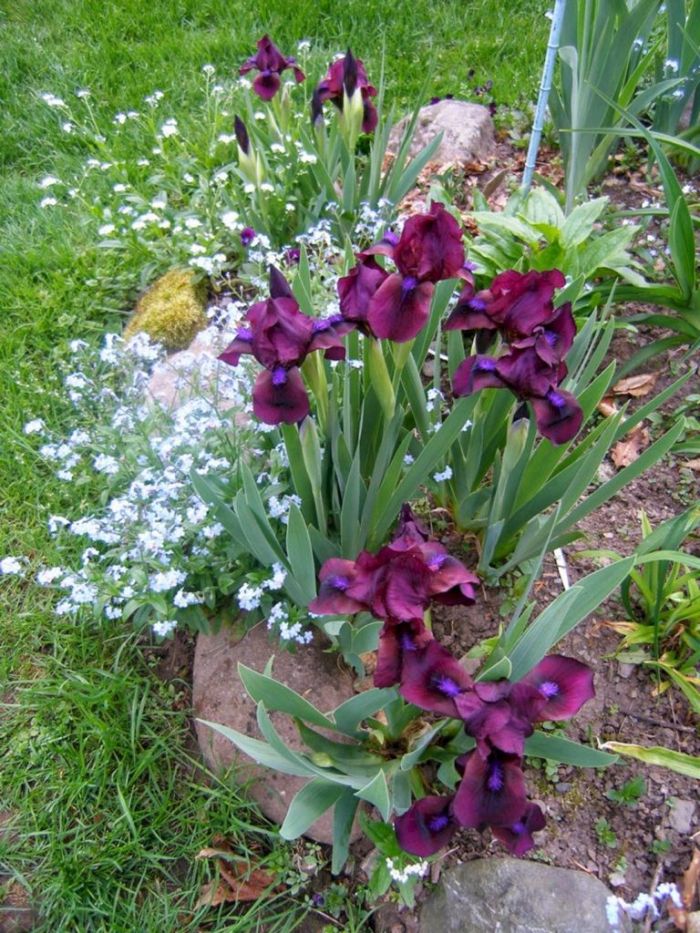Iris, an amazing plant for yard and garden – secrets for planting and care
Iris is a perennial herbaceous plant that gives us enchanting flowers with a huge variety of colors in the garden or balcony. It is no coincidence that, in Greek mythology, Iris was the goddess of the rainbow. The iris is planted in autumn and gives us its spectacular bloom in spring with beautiful flowers that stand out for their delicate and attractive appearance. And from colors? Blue, white, red, yellow, orange and even black! There are also beautiful two-tone irises with color combinations. We can decorate the iris flowers in the living room by making blooming bouquets that we keep in a vase for 2-3 weeks.

The best flowering plants for the cutest garden
What conditions are suitable for planting the iris?
The iris grows in fertile and slightly acidic soils. In order to thrive and give us her wonderful flowers, she prefers well-drained soil with little to no water. It also needs enough sunshine to produce a rich bloom, and if placed in shady places it may not bloom at all. Planting the iris is very close to the ground, 3-5 cm deep in the coldest areas, while in warm areas we do a little deeper planting at 5-10 cm. The planting distances between the bulbs or the iris rhizomes are 20-30 cm. To plant the iris in a flowerpot, we select a balcony facing south or west and use a generic herb. We make sure that our flower pot has holes, and it is advisable to place a layer of pebbles or pebbles at its base to remove water better.
What care for watering and fertilizing does the iris need?
Iiris is quite durable and not demanding at all. Even a little distant to forget, it won’t be a problem. Generally, the iris needs more regular watering, 1-2 times a week, once it sprouts until flowering begins. Be careful though, as excessive watering can cause its roots to rot. And as for lubrication, there too the iris is scarce. Add a bit of whole grain fertilizer during planting, which we mix with the soil or potting soil if we have planted in a pot. We then repeat in the early spring a second full fertilizer application avoiding the use of nitrogen fertilizers.

Zinnia – the most colorfur flowers for your garden
What diseases and insects infest the iris?
The iris is not particularly affected by diseases and insects. To protect it from the insect that squeezes plant tissue and generates characteristic honeycombs, we can prevent it by spraying it with a green soap solution made by dissolving 20 grams of crushed green soap and 5 ml of alcohol in 1 liter of water. In conditions of excessive moisture and poor drainage, the iris can be affected by fungal diseases that cause spasms in the rhizomes and bulbs. In this case, irrigate the root of the iris with a solution of copper sulphate (blue stone) to combat it.
How does the iris multiply?
Iris is multiplied by bulbs or by the division of the rhizomes, depending on the species and variety. However, if we do not want to buy bulbs and iris rhizomes every year, we follow our well-known storage procedure for all bulbous flowers. We remove the bulbs of the plant from the ground, remove any soil left over, and check for any diseases, rotting or blows. Those bulbs that are in good condition are stored in a cardboard box with light vents for good ventilation. In the box we add sawdust or rice to absorb any moisture so that the bulb does not germinate prematurely and then rot.

Garden lilac, a spectacular and easy to care decorative tree for your garden
And one last secret about the iris
There is also a distinct aquatic iris variety, the watermelon, which lives and grows in its rhizomes in the water and forms striking yellow flowers. Ideal for small ponds and fountains in our garden.
Just have a peek at the pictures given below to find out what kind of designs you are ready to incorporate into your garden.





















Images via: Pinterest







3 comments
[…] Iris, an amazing plant for yard and garden – secrets for planting and care […]
[…] SOURCE : https://mydesiredhome.com/iris-an-amazing-plant-for-yard-and-garden-secrets-for-planting-and-care/?f…; […]
[…] clematis, lupins, irises, bluebells, sage, asters, phlox, perennial geraniums, lavender, […]
Comments are closed.